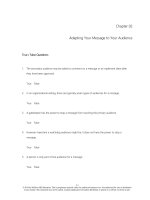Business communication building critical skill 3rd by locker module 12
Bạn đang xem bản rút gọn của tài liệu. Xem và tải ngay bản đầy đủ của tài liệu tại đây (335.26 KB, 14 trang )
PPT
PPT
Module
Module 12
12
Persuasive
Persuasive
Messages
Messages
McGraw-Hill/Irwin
©2007, The McGraw-Hill Companies, All Rights
12-2
Persuasive
Persuasive Messages
Messages
To learn how to
Choose and implement a persuasive
strategy.
Write effective subject lines for
persuasive messages.
Organize persuasive messages.
Identify and overcome objections.
12-3
Persuasive
Persuasive Messages
Messages
To learn how to
Write common kinds of persuasive
messages.
Continue to analyze business
communication situations.
12-4
Persuasive
Persuasive Messages
Messages
Start by answering these questions:
What is the best persuasive strategy?
What is the best subject line for a
persuasive message?
How should I organize persuasive
messages?
How do I identify and overcome
objections?
12-5
Persuasive
Persuasive Messages
Messages
Start by answering these questions:
What other techniques can make my
messages more persuasive?
What are the most common kinds of
persuasive messages?
How can PAIBOC help me write
persuasive messages?
12-6
Kinds
Kinds of
of Persuasive
Persuasive Messages
Messages
Orders and Requests
Proposals and Recommendations
Sales and Fund-Raising Letters
Job Application Letters
Reports (if they recommend
action)
12-7
Persuasive
Persuasive Messages
Messages
Primary Purposes
To have the reader act.
To provide enough information so
the reader knows exactly what to do.
To overcome any objections that
might prevent or delay action.
12-8
Persuasive
Persuasive Messages
Messages continued
continued
Secondary Purposes
To build a good image of the writer.
To build a good image of the writer’s
organization.
To cement a good relationship
between the writer and reader.
To reduce or eliminate future
correspondence on the same matter.
12-9
Direct
Direct Requests
Requests
Use when
The audience will do as you ask
without resistance.
You need a response only from
people willing to act.
The audience is busy and may not
read all messages.
Your organization’s culture prefers
them.
1210
Direct
Direct Requests
Requests continued
continued
Follow this pattern.
Consider asking immediately for the
information or service you want.
Give readers all the information and
details they need to act on the
request.
Ask for the action you want.
1211
Problem-Solving
Problem-Solving Messages
Messages
Use when
The audience is likely to object.
You need action from everyone.
You trust the audience to read the
entire message.
You expect logic to be more
important than emotion in the
decision.
Problem-Solving
Problem-Solving Messages
Messages
continued
continued
Follow this pattern
Describe the problem you both share.
Give the details of the problem.
Explain the solution to the problem.
Show that any negative elements are
outweighed by advantages.
Summarize any additional benefits.
Ask for the action you want.
1212
1213
Overcoming
Overcoming Objections
Objections
Specify how much time/money is
required.
Put the time/money in the context
of the benefits they bring.
Show that money spent now saves
money later.
Show benefits to another group or
cause.
1214
Overcoming
Overcoming Objections
Objections continued
continued
Show that sacrifice is needed for a
higher goal.
Show that advantages outweigh
disadvantages.
Turn a disadvantage into an
opportunity.









